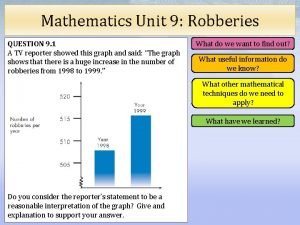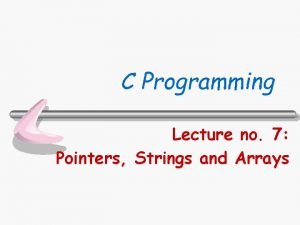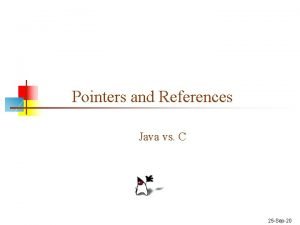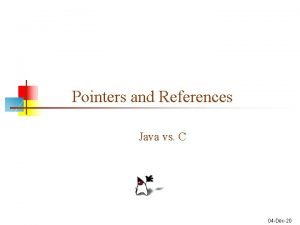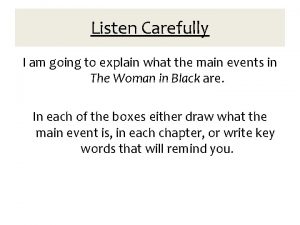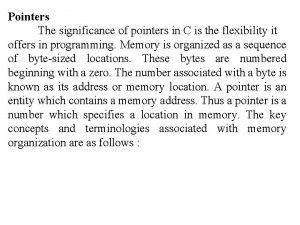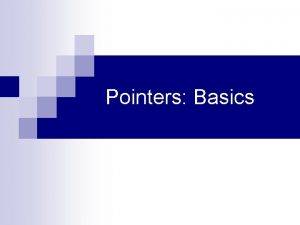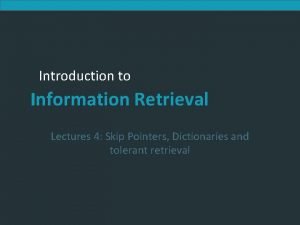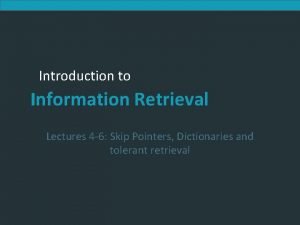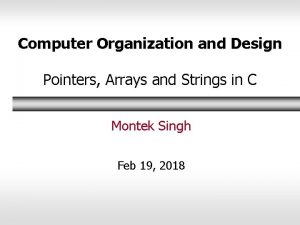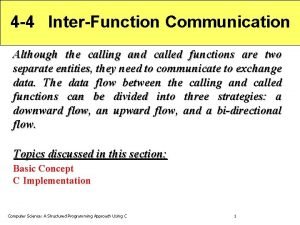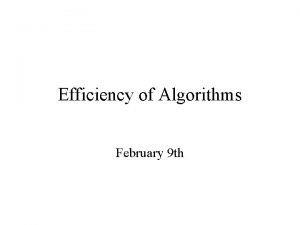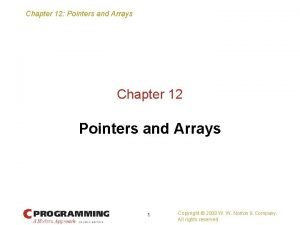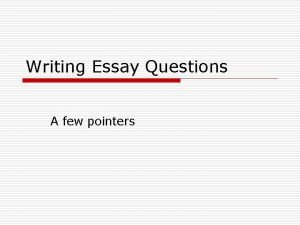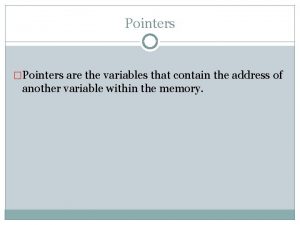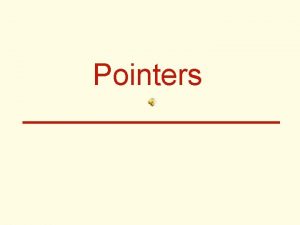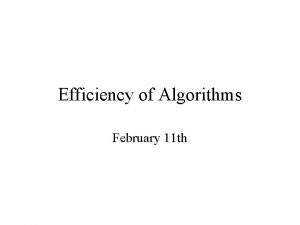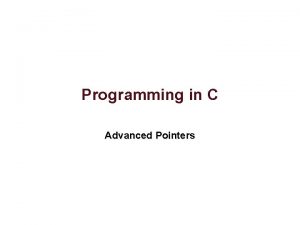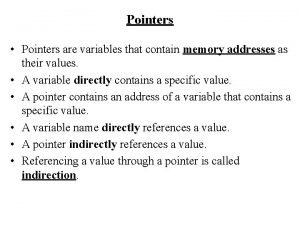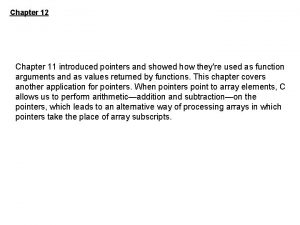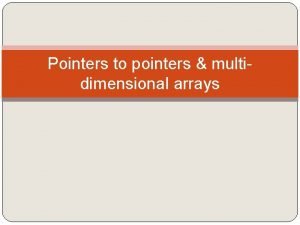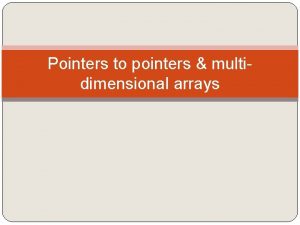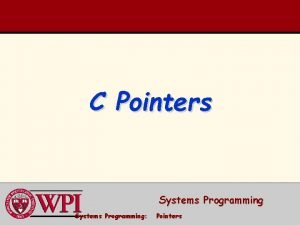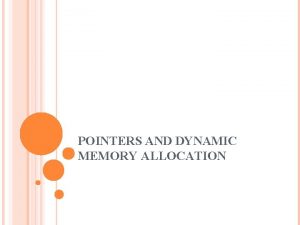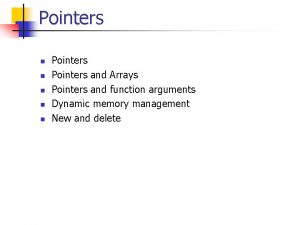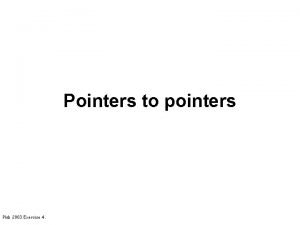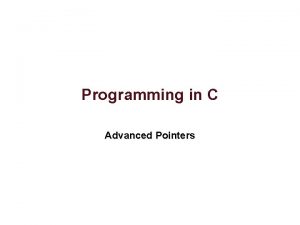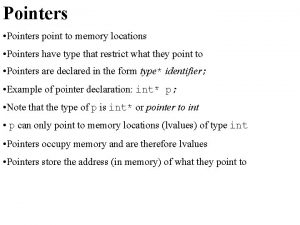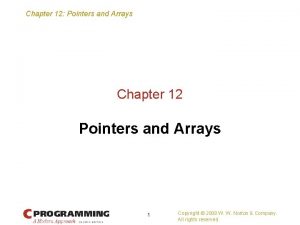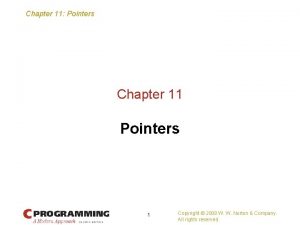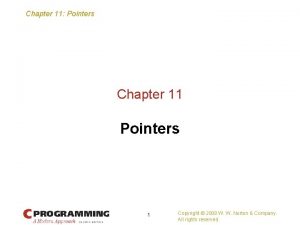Chapter 11 introduced pointers and showed how theyre


![We can now access a [ 0 ] through p; for example, we can We can now access a [ 0 ] through p; for example, we can](https://slidetodoc.com/presentation_image_h/7c2a82e7b007c20a4c51b4c02a0ccaa0/image-3.jpg)







![The condition p < &a [N] in the for statement deserves special mention. In The condition p < &a [N] in the for statement deserves special mention. In](https://slidetodoc.com/presentation_image_h/7c2a82e7b007c20a4c51b4c02a0ccaa0/image-11.jpg)


















![The loop begins with p pointing to a [ 0 ]. Successive increments of The loop begins with p pointing to a [ 0 ]. Successive increments of](https://slidetodoc.com/presentation_image_h/7c2a82e7b007c20a4c51b4c02a0ccaa0/image-30.jpg)

![Since a [ i ] is a pointer to row i of the array Since a [ i ] is a pointer to row i of the array](https://slidetodoc.com/presentation_image_h/7c2a82e7b007c20a4c51b4c02a0ccaa0/image-32.jpg)


- Slides: 34

Chapter 11 introduced pointers and showed how they're used as function arguments and as values returned by functions. This chapter covers another application for pointers. When pointers point to array elements, C allows us to perform arithmetic—addition and subtraction—on the pointers, which leads to an alternative way of processing arrays in which pointers take the place of array subscripts.

12. 1 Pointer Arithmetic Pointers can point to array elements, not just ordinary variables. For example, suppose that a and p have been declared as follows: int a [10] , *p; We can make p point to a [ 0 ] by writing p == &a[0]; Graphically, here's what we've just done:
![We can now access a 0 through p for example we can We can now access a [ 0 ] through p; for example, we can](https://slidetodoc.com/presentation_image_h/7c2a82e7b007c20a4c51b4c02a0ccaa0/image-3.jpg)
We can now access a [ 0 ] through p; for example, we can store the value 5 in a[0] by writing *p == 5; Here's our picture now:

Making a pointer p point to an element of an array a isn't particularly exciting. However, by performing pointer arithmetic (or address arithmetic) on p, we can access the other elements of a. C supports three (and only three) forms of pointer arithmetic: adding an integer to a pointer subtracting an integer from a pointer subtracting two pointers Let's take a close look at each of these operations. Our examples assume the following declarations: int a[10], *p, *q, i;

Adding an integer j to a pointer p yields a pointer to the element that is j places after the one that p points to. More precisely, if p points to the array element a [ i ], then p + j points to a [ i+j ] (provided, of course, that a [ i+j ] exists). The following example illustrates pointer addition; diagrams show the values of p and q at various points in the computation.

Subtracting an Integer from a Pointer If p points to the array element a [ i ], then p — j points to a [ i - j ]. For example:

Subtracting Pointers When two pointers are subtracted, the result is the distance (measured in array elements) between the pointers. Thus, if p points to a [ i ] and q points to a [ j ], then p - q is equal to i - j. For example: P = &a[5]; Q = &a[1]; i = p – q; i = q – q; /* i is 4 */ /* i is -4 /* Note: Performing arithmetic on a pointer p gives a meaningful result only when p points to an array element. Furthermore, subtracting two pointers is meaningful only when both point to elements of the same array.

Comparing Pointers We can compare pointers using the relational operators (<, <=, >, >=) and the equality operators (== and ! ==). Using the relational operators to compare two pointers is meaningful only when both point to elements of the same array. The outcome of the comparison depends on the relative position of the two elements in the array. For example, after the assignments P = &a[5] ; q = &a[I] ; the value of p <= q is 0 and the value of p >= q is 1.

12. 2 Using Pointers for Array Processing Pointer arithmetic allows us to visit the elements of an array by repeatedly incrementing a pointer variable. The following program fragment, which sums the elements of an array a, illustrates the technique. In this example, the pointer variable p initially points to a [ 0 ]. Each time through the loop, p is incremented; as a result, it points to a [1], then a [2 ], and so forth. The loop terminates when p steps past the last element of a. *define N 10 int a[N], sum, *p; sum = 0 ; for (p = &a[0]; p < &a[N]; p++) sum += *p; The following figures show the contents of a, sum, and p at the end of the first three loop iterations (before p has been incremented).

At the end of the first Interation: At the end of the second Interation: At the end of the third Interation:
![The condition p a N in the for statement deserves special mention In The condition p < &a [N] in the for statement deserves special mention. In](https://slidetodoc.com/presentation_image_h/7c2a82e7b007c20a4c51b4c02a0ccaa0/image-11.jpg)
The condition p < &a [N] in the for statement deserves special mention. In Standard C, it's legal to apply the address operator to a [N], even though this element doesn't exist (a is indexed from 0 to N - 1). Using a [N] in this fashion is perfectly safe, since the loop doesn't attempt to examine its value. The body of the loop will be executed with p equal to &a [0], &a [1], . . . , &a [N-1], but when p is equal to &a [N], the loop terminates. We could just as easily have written the loop without pointers, of course, using subscripting instead. The argument most often cited in support of pointer arithmetic is that it can save execution time. However, that depends on the implementation—some C compilers actually produce better code for loops that rely on subscripting.

Combining the * and ++Operators C programmers often combine the * (indirection) and + + operators in statements that process array elements. Consider the simple case of storing a value into an array element, then advancing to the next element. Using array subscripting, we might write a[i++] = j; If p is pointing to an array element, the corresponding statement would be *p++ = j; Because the postfix version of ++ takes precedence over *, the compiler sees this as *(p++) = j; The value of p++ is p. (Since we're using the postfix version of ++, p won't be incremented until after the expression has been evaluated. ) Thus, the value of * (p++) will be *p—the object to which p is pointing.

Of course, *p++ isn't the only legal combination of * and ++. We could write (*p) ++, for example, which returns the value of the object that p points to, then increments that object (p itself is unchanged). If you find this confusing, the following table may help: Expression *p++ or * (p++) (*p) ++ *++p or * (++p) ++ *p or ++ (*p) Meaning Value of expression is *p before increment; increment p later Value of expression is *p before increment; increment *p later Increment p first; value of expression is *p after increment Increment *p first; value of expression is *p after increment All four combinations appear in programs, although some are far more common than others. The one we'll see most frequently is *p++, which is handy in loops. Instead of writing for (p = &a[0]; p < &a[N]; p++) sum += *p; to sum the elements of the array a, we could write p = &a[0] ; while (p < &a[N]) sum +== *p++;

The * and -- operators mix in the same way as * and ++. For an application that combines * and --, let's return to the stack example of Section 10. 2. The original version of the stack relied on an integer variable named top to keep track of the "top-of-stack" position in the contents array. Let's replace top by a pointer variable that points initially to element 0 of the contents array: int *top_ptr = &contents [0] ; Here are the new push and pop functions (updating the other stack functions is left as an exercise): void push(int i) { if (is_full()) stack_overflow(); else *top_ptr++ = i; }

int pop(void) { if (is_empty()) stack_underflow(); else return *--top_ptr; } Note that I've written *--top_ptr, not *top_ptr--, since I want pop to decrement top_ptr before fetching the value to which it points.

12. 3 Using an Array Name as a Pointer arithmetic is one way in which arrays and pointers are related, but it's not the only connection between the two. Here's another key relationship: The name of an array can be used as a pointer to the first element in the array. This relationship simplifies pointer arithmetic and makes both arrays and pointers more versatile. For example, suppose that a is declared as follows: int a[10] ; Using a as a pointer to the first element in the array, we can modify a [ 0 ]: *a = 7; /* stores 7 in a[0] */ We can modify a [1] through the pointer a + 1: *(a+l) = 12; /* stores 12 in a[1] */ In general, a + i is the same as &a [ i ] (both represent a pointer to element i of a) and * (a+i) is equivalent to a[i] (both represent element i itself). In other words, array subscripting can be viewed as a form of pointer arithmetic.

The fact that an array name can serve as a pointer makes it easier to write loops that step through an array. Consider the following loop from Section 12. 2: for (p = &a[0]; p < &a[N]; p++) sum += *p; To simplify the loop, we can replace &a [ 0 ] by a and &a [N] by a + N: for (p = a; p < a + N; p++) sum += *p; Although an array name can be used as a pointer, it's not possible to assign it a new value. Attempting to make it point elsewhere is an error: while (*a != 0) a++; /*** WRONG ***/ This is no great loss; we can always copy a into a pointer variable, then change the pointer variable: p = a; while (*p != 0) p++;

Reversing a Series of Numbers (Revisited) The reverse. c program of Section 8. 1 reads ten numbers, then writes the numbers in reverse order. As the program reads the numbers, it stores them in an array. Once all the numbers are read, the program steps through the array backwards as it prints the numbers. The original program used subscripting to access elements of the array. Here's a new version in which I've replaced subscripting with pointer arithmetic.

/* Reverses a series of numbers (pointer version) */ #include <stdio. h> #define N 10 main() { int a[N], *p; printf("Enter %d numbers: ", N) ; for (p = a; p < a + N; p++) scanf("%d", p) ; printf("In reverse order: ") ; for (p = a + N - 1; p >= a; p--) printf(" %d", *p) ; printf("n") ; return 0; }

In the original program, an integer variable i kept track of the current position within the array. Our new version replaces t with p, a pointer variable. The numbers are still stored in an array; we're simply using a different technique to keep track of where we are in the array. Note that the second argument to scanf is p, not &p. Since p points to an array element, it's a satisfactory argument for scanf; &p, on the other hand, would be a pointer to an array element.

Array Arguments (Revisited) When passed to a function, an array name is always treated as a pointer. Consider the following function, which returns the largest element in an array of integers: int find_largest(int a[], int n) { int i, max; max = a [ 0 ] ; for (i = 1; i < n; i++) if (a[i] > max) max = a[i]; return max; } Suppose that we call find_largest as follows: largest = find_largest(b, N); This call causes a pointer to the first element of b to be assigned to a; the array itself isn't copied.

The fact that an array parameter is treated as a pointer has some important consequences: When an ordinary variable is passed to a function, its value is copied; any changes to the corresponding parameter don't affect the variable. In contrast, an array used as an argument isn't protected against change, since no copy is made of the array itself. For example, the following function modifies an array by storing zero into each of its elements: void store_zeros(int a[], int n) { int i; for (i =0; i < n; i++) a[i] = 0; } To indicate that an array parameter won't be changed, we can include the word const in its declaration: int find_largest(const int a[], int n) { … } If const is present, the compiler will check that no assignment to an element of a appears in the body of find_largest.

• The time required to pass an array to a function doesn't depend on the size of the array. There's no penalty for passing a large array, since no copy of the array is made. • An array parameter can be declared as a pointer if desired. For example, firid_largest could be defined as follows: int fincl_largest (int *a, int n) { … } Declaring a to be a pointer is equivalent to declaring it to be an array; the compiler treats the declarations as though they were identical.

Although declaring a parameter to be an array is the same as declaring it to be a pointer, the same is not true for a variable. The declaration int a[10]; causes the compiler to set aside space for ten integers. In contrast, the declaration int *a; causes the compiler to allocate space for a pointer variable. In the latter case, a is not an array; attempting to use it as an array can have disastrous results. For example, the assignment *a = 0; /*** WRONG ***/ will store 0 where a is pointing. Since we don’t know where a is pointing, the effect on the program is unpredictable.

• A function with an array parameter can be passed an array "slice"—a sequence of consecutive elements. Suppose that we want find_largest to locate the largest element in some portion of an array b, say elements b [ 5 ], . . . , b[14]. When we call find_largest, we'll pass it the address of b [ 5 ] and the number 10, indicating that we want find_largest to examine ten array elements, starting at b [ 5 ]: largest = find_largest(&b[5], 10);

Using a Pointer as an Array Name If we Can use an array name as a pointer, will C allow us to subscript a pointer as though it were an array name? By now, you'd probably expect the answer to be yes, and you'd be right. Here's an example: #define N 100 int a[N], i, sum =0, *p = a; for (i = 0; i < N; i++) sum += p[i]; The compiler treats p[i] as *(p+i), which is a perfectly legal use of pointer arithmetic. Although the ability to subscript a pointer may seem to be little more than a curiosity, we’ll see in Section 17. 3 that it's actually quite useful.

Pointers and Multidimensional Arrays Just as pointers can point to elements of one-dimensional arrays, they can also point to elements of multidimensional arrays. In this section, we'll explore common techniques for using pointers to process the elements of multidimensional arrays. For simplicity, we'll stick to two-dimensional arrays, but everything we'll do applies equally to higher-dimensional arrays.

Processing the Elements of a Multidimensional Array We saw in Section 8. 2 that C always stores two-dimensional arrays in row-major order; in other words, the elements of row 0 come first, followed by the elements of row 1, and so forth. An array with r rows would have the following appearance: We can take advantage of this layout when working with pointers. If we make a pointer p point to the first element in a two-dimensional array (the element in row 0, column 0), we can visit every element in the array by incrementing p repeatedly.

As an example, let's look at the problem of initializing all elements of a twodimensional array to zero. Suppose that the array has been declared as follows: int a[NUM_ROWS][NUM_COLS]; The obvious technique would be to use nested for loops: int row, col; for (row= 0; row < NUM_ROWS; row++) for (col = 0; col < NUM_COLS; col++) a[row][col] = 0; But if we view a as a one-dimensional array of integers (which is how it's stored), we can replace the pair of loops by a single loop: int *p ; for (p = &a[0][0]; p <=&a[NUM_ROWS-l] [NUM_COLS-1] ; p++) *p = 0;
![The loop begins with p pointing to a 0 Successive increments of The loop begins with p pointing to a [ 0 ]. Successive increments of](https://slidetodoc.com/presentation_image_h/7c2a82e7b007c20a4c51b4c02a0ccaa0/image-30.jpg)
The loop begins with p pointing to a [ 0 ]. Successive increments of p make it point toa[0][l], a[0][2], and so on. When p reaches a [ 0 ] [NUM_COLS-1 ] (the last element in row 0), incrementing it again makes p point to a [ 1 ] [ 0 ], the first element in row 1. The process continues until p goes past a [NUM_ROWS-1] [NUM_COLS-1], the last element in the array. Although treating a two-dimensional array as one-dimensional may seem like cheating, it's perfectly legal in C. Whether it's a good idea to do so is another matter. Techniques like this one definitely hurt program readability, but—at least with some older compilers—produce a compensating increase in efficiency. With many modern compilers, though, there's often little or no speed advantage.

Processing the Rows of a Multidimensional Array What about processing the elements in just one row of a two-dimensional array? Again, we have the option of using a pointer variable p. To visit the elements of row i, we'd initialize p to point to element 0 in row i in the array a: p = &a[i][0] ; Or we could simply write p = a[i] ; since, for any two-dimensional array a, the expression a [i] is a pointer to the first element in row i. To see why this works, recall the magic formula that relates array subscripting to pointer arithmetic: for any array a, the expression a [ i ] is equivalent to * (a + i). Thus, &a[i] [0] is the same as &(* (a[i] + 0) ), which is equivalent to &*a [i], which is the same as a [i], since the & and * operators cancel. We'll use this simplification in the following loop, which clears row i of the array a: int a[NUM_ROWS][NUM_COLS], *p, i; … for (p = a[i]; p< a[i] + NUM_COLS; p++) *p = 0;
![Since a i is a pointer to row i of the array Since a [ i ] is a pointer to row i of the array](https://slidetodoc.com/presentation_image_h/7c2a82e7b007c20a4c51b4c02a0ccaa0/image-32.jpg)
Since a [ i ] is a pointer to row i of the array a, we can pass a [ i ] to a function that's expecting a one-dimensional array as its argument. In other words, a function that's designed to work with one-dimensional arrays will also work with a row belonging to a two-dimensional array. As a result, functions such as find_largest and store_zeros are more versatile than you might expect. Consider find_largest, which we originally designed to find the largest element of a one-dimensional array. We can just as easily use find_largest to determine the largest element in one row of a two-dimensional array: largest = find_largest(a[i], NUM_COLS);

Using the Name of a Multidimensional Array as a Pointer Just as the name of a one-dimensional array can be used as a pointer, so can the name of any array, regardless of how many dimensions it has. Some care is required, though. Consider the following arrays: int a[10], b[10] ; Although we can use a as a pointer to the element a [ 0 ], it's not the case that b is a pointer to b [ 0 ]; instead, it's a pointer to b [ 0 ]. This makes more sense if we look at it from the standpoint of C, which regards b not as a two-dimensional array but as a one-dimensional array whose elements are one-dimensional arrays. In terms of types, a can be used as a pointer of type int *, whereas b—when used as a pointer—has type int * * (pointer to int).

For example, consider how we might use find_largest to find the largest element in the following two-dimensional array: int a[NUM_ROWS][NUM_COLS] ; Our plan is to trick find_largest into thinking that a is one-dimensional. As the first argument to find_largest, we'll try passing a (the address of the array); as the second, we'll pass NUM_ROWS * NUM_COLS (the total number of elements in a): largest = find_largest (a, NUM_ROWS *NUM__COLS); /* WRONG*/ This statement won't compile, because a has type int ** and find_largest is expecting an argument of type int *. The correct call is largest = find_largest(a[0]/ NUM_ROWS * NUM_COLS) ; a [ 0 ] points to element 0 in row 0, and it has type int *, so the call will work correctly.
 Scrambled paragraph writing activity
Scrambled paragraph writing activity Some of the changes brian underwent were permanent
Some of the changes brian underwent were permanent A tv reporter showed this graph and said
A tv reporter showed this graph and said Pointers and strings
Pointers and strings & vs * in c
& vs * in c Java pointers and references
Java pointers and references The election of 1800 showed that
The election of 1800 showed that Nethinim
Nethinim Sally showed absolutely no fear when climbing the wall
Sally showed absolutely no fear when climbing the wall Definition of extended metaphor
Definition of extended metaphor Caedb
Caedb Importance of pointers
Importance of pointers C array of pointers to structs
C array of pointers to structs Pointers basics
Pointers basics Skip pointer
Skip pointer For skip pointer, more skip leads to
For skip pointer, more skip leads to Which is a good idea for using skip pointers
Which is a good idea for using skip pointers Explicit pointers
Explicit pointers Java array pointer
Java array pointer Inter function communication
Inter function communication Glsl pointers
Glsl pointers Shuffle left algorithm
Shuffle left algorithm Hazard pointers
Hazard pointers 12 pointers
12 pointers I-need-a-few-pointers-98hpou5
I-need-a-few-pointers-98hpou5 Science fair logbook example
Science fair logbook example Science fair logbook example
Science fair logbook example Pointers are variables that contain
Pointers are variables that contain What is the fundamental of pointers?
What is the fundamental of pointers? Pointers are variables that contain as their values
Pointers are variables that contain as their values Converging pointers algorithm
Converging pointers algorithm Advanced pointers in c
Advanced pointers in c Constant pointer and pointer to constant
Constant pointer and pointer to constant Pointers are variables that contain as their values
Pointers are variables that contain as their values Pingo upb
Pingo upb


